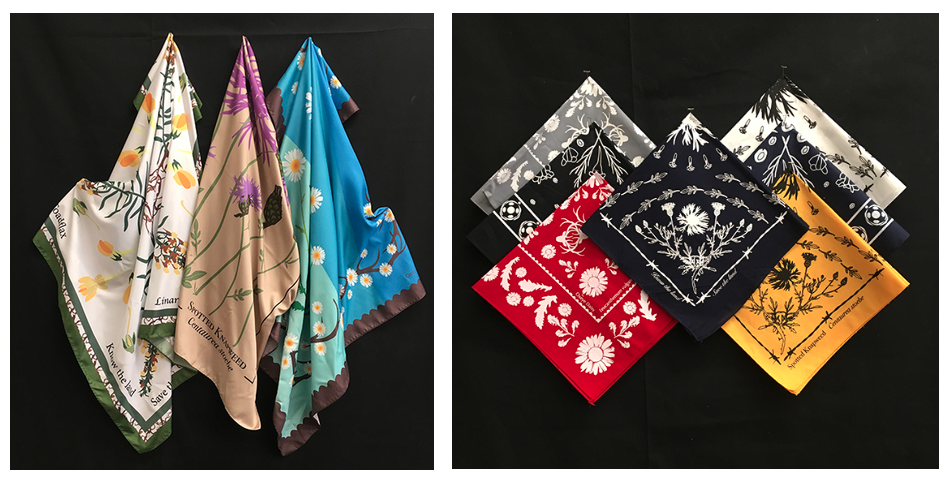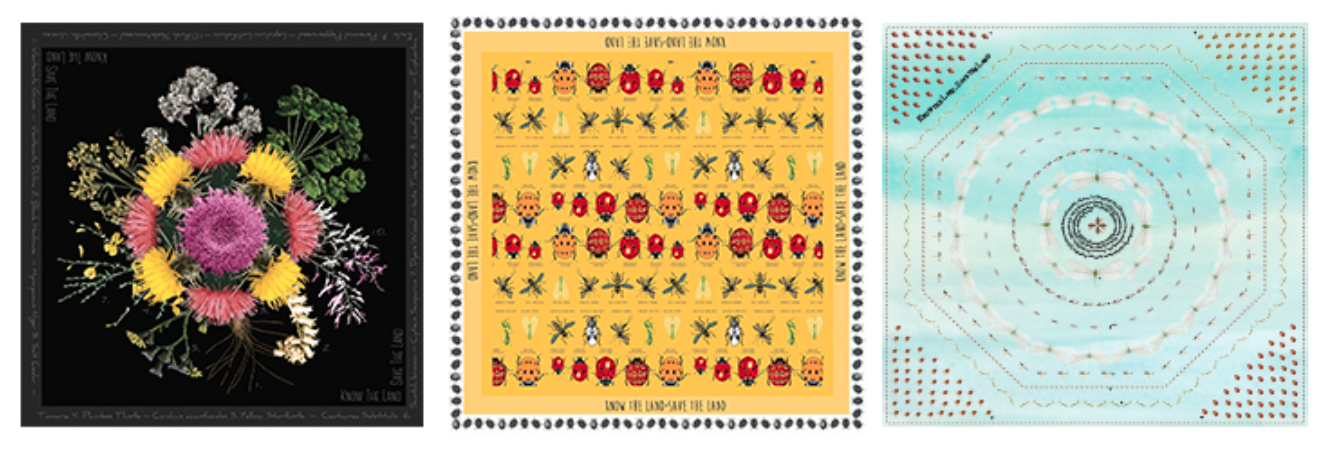 |
June 2020
|
June 2020 // Volume 58 // Number 3 // Ideas at Work // v58-3iw1
Know the Land, Save the Land: Apparel Design for Extension Education
Abstract
We leveraged collaboration by a county Extension office, apparel design undergraduate students, and university faculty to develop an innovative educational product to capture the attention of new audiences for invasive plant education programming. Nationwide press highlighted the project—titled Know the Land, Save the Land—generating national interest and sales. We achieved our goal of using innovative educational materials to reach new audiences for Extension education. As well, the project is fiscally self-sustaining and continues to support experiential student learning opportunities for apparel design students through future product releases.
Introduction
The Know the Land, Save the Land (KTLSTL) project described in this article attracted national attention to a University of Idaho (UI) Extension program focused on outreach efforts to increase awareness and identification of invasive plants. In a 2009 study, University of Florida Extension educators found that 46% of the 58 Extension agents interviewed perceived lack of public interest, knowledge, and awareness as primary challenges in communicating with the general public, and one agent complained that the Extension educational topics presented were not exciting enough to draw committed attendees (Brain, Irani, Hodges, & Fuhrman, 2009). Along these lines, invasive plant education in Valley County, Idaho, had failed to attract broad audience participation. KTLSTL was developed to reach beyond typical Extension audiences and involves use of a wearable educational product to engage new stakeholders. Novel approaches to Extension education are needed to increase excitement surrounding Extension's outreach efforts and to engage new audience members. As two Extension educators and a university instructor in apparel, textiles, and design (ATD), we developed bandanas and scarves to distribute invasive plant identification information to stakeholders, with the goal of increasing awareness of invasive plant species affecting Valley County.
Project Description and Development
We chose bandanas and scarves as communication tools for this project because of their popular appeal, history of visual design, utility, and generic sizing (one size fits all). In fall 2016, we obtained $600 in funding to develop prototypes. ATD students enrolled in a Portfolio Development course were organized into product design teams and tasked with creating designs. An advisory committee composed of experts in Extension education, plant science, and apparel design was established to ensure accurate scientific representation of species and appropriate use of design methodology. Our project objectives were (a) to produce a new educational product, (b) to reach stakeholders new to UI Extension education programs, (c) to make the project financially self-sustaining, and (d) to provide students with an experiential learning opportunity.
The teams created designs for three invasive plants that balanced educational requirements with aesthetic appeal (Figure 1). Each design was required to include clear imagery of the plant, attention on specific plant parts, and both the common and Latin names of the plant. With the advisory committee and designers geographically dispersed, we relied on the distance conferencing software Zoom for meetings, a tactic that further replicated real-life employment meeting settings. The student teams developed concepts and design options for each plant/product combination using Adobe Illustrator and presented this information to the advisory committee for selection of final designs. Bandana and scarf designs were sent digitally to Spoonflower (a web-based custom digital printing service), and the fabric edges were finished by a local sewing company. The KTLSTL project allowed students to use learned course knowledge to solve real-world problems and gain valuable professional experience (Angima & Gaebel, 2018; Kolb, 1984).
Figure 1.
Know the Land, Save the Land Product Designs From Fall 2016

In 2018, KTLSTL was awarded a Critical Issues Grant ($4,750) from the UI College of Agriculture and Life Sciences (CALS) to support innovative projects that address significant issues affecting Idahoans. This grant funded the next phase of product development as we moved into production and retail sales through an e-commerce portal. The prototypes from the pilot program demonstrated proof of concept and allowed us to collect valuable information from product opinion survey respondents and focus groups. This information was used for product development decisions including those related to price, design preferences, and product distribution. We purchased packaging, hangtags, and inventory quantities using funds from the Critical Issues Grant. The scarves and bandanas are available as educational products on their own, or they can be bundled with the Idaho Noxious Weed Guide Book. Inventory management and order fulfillment are coordinated by the CALS publications manager located on the UI campus.
Outcomes
We met our first objective by successfully producing a new educational product. The scarves and bandanas are aesthetically appealing and, more importantly, contain accurate information that meets the educational needs of Extension.
The publicity that was generated around the product launch expanded stakeholder interest in UI Extension programming, thus allowing us to meet our second objective. Website sales launched in December 2017, and CALS Communications featured the project in a press release (Parrella, 2017). In February 2018, an Associated Press article featuring the project was shared in national news outlets including The Denver Post, Miami Herald, U.S. News & World Report, The Spokesman-Review, and The Sacramento Bee (Boone, 2018). The readerships of these news outlets far exceed the total population of Valley County, Idaho (10,000), and such publicity broadened the reach of the project by creating excitement around UI Extension educational programming. New audiences were anticipated, but a national audience was not expected. Product orders were received from 13 states, and we were contacted by organizations in Florida and Colorado for product donations.
We met our third objective of making the project financially self-sustaining through the successful launch of website sales. Our first inventory sold out in 6 months, requiring us to order additional product for fall 2018 to meet consumer demand. Currently, revenue from product sales supports development of new designs and purchases of new inventory.
The project itself met the fourth objective of providing an experiential learning opportunity for ATD undergraduate students. Students increased their skills in product research and design, in-person and virtual communications, time line management, and teamwork. The final product made a meaningful contribution to each student's professional portfolio.
Conclusion and Future Designs
Innovative educational tools are critical for capturing stakeholder and media attention to amplify the impacts of Extension programming to the public. By looking to interdisciplinary collaborations, we developed a new educational product. Undergraduate students learned about developing a fiscally sustainable project model for future projects.
KTLSTL products are easily adapted to new topic ideas to address current and emerging areas of Extension programming. Student designs for the fall 2020 products focus on beneficial insect species as part of a statewide integrated pest management strategy (Figure 2).
Figure 2.
Proposed Know the Land, Save the Land Designs for Fall 2020 Product Line

We are hopeful that our consumer audience will stay engaged in the natural resources management messaging of KTLSTL products and share this message with new audience members. As well, we hope our project can serve as inspiration for other Extension professionals with regard to development of new avenues for Extension education.
Acknowledgments
We would like to thank the following people (and their organizations) for their contributions to the KTLSTL project: ATD Portfolio Development undergraduate students (fall 2016 and 2018); Therese Harris, Jean Parrella, and Amy Calabretta (UI Extension Publishing/Communications); advisory committee members Durena Farr (Valley Soil & Water), Steve Anderson (Valley County Weed Superintendent), Montessa Young (UI Extension), Tim Prather (UI faculty), Jennifer Stady (Laundry Studio founder), Steve Jirik (Idaho Bureau of Land Management), Erika Schmidt, and Diane Daley-Laursen.
References
Angima, S., & Gaebel, K. (2018). Collaborative community engagement: Experiential learning opportunities for college students via Extension. Journal of Extension, 56(7), Article v56-7iw1. Available at: https://www.joe.org/joe/2018december/iw1.php
Boone, R. (2018). Noxious weed or fine apparel? Idaho educator says "both." The Spokesman-Review. Retrieved from https://www.spokesman.com/stories/2018/feb/22/noxious-weed-or-fine-apparel-idaho-educator-says-b/
Brain, R., Irani, T., Hodges, A., & Fuhrman, N. (2009). Agricultural and natural resources awareness programming: Barriers and benefits as perceived by county Extension agents. Journal of Extension, 47(2), Article v47-2a3. Available at: https://joe.org/joe/2009april/a3.php
Kolb, D. (1984). Experiential learning: Experience as the source of learning and development. Englewood Cliffs, NJ: Prentice-Hall, Inc.
Parrella, J. (2017). Identifying noxious weeds through fashion. Retrieved from the University of Idaho College of Agricultural and Life Sciences website: https://www.uidaho.edu/extension/news/story/communication-through-apparel




